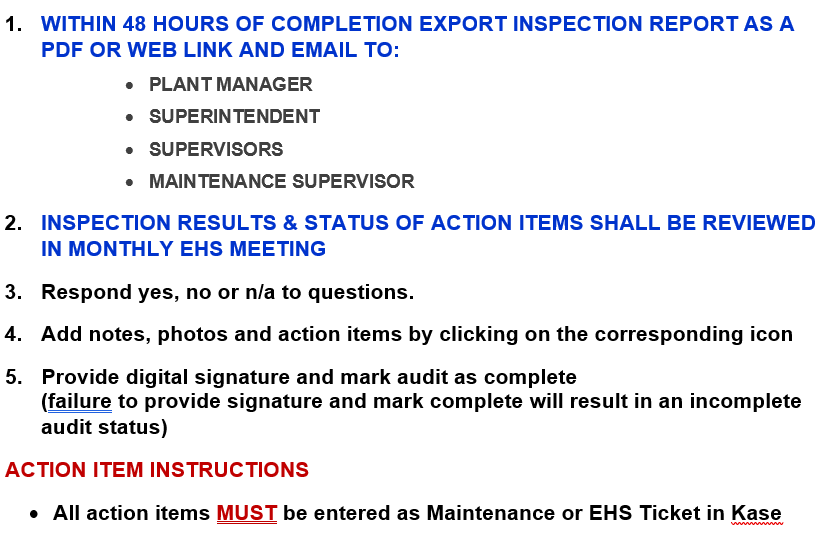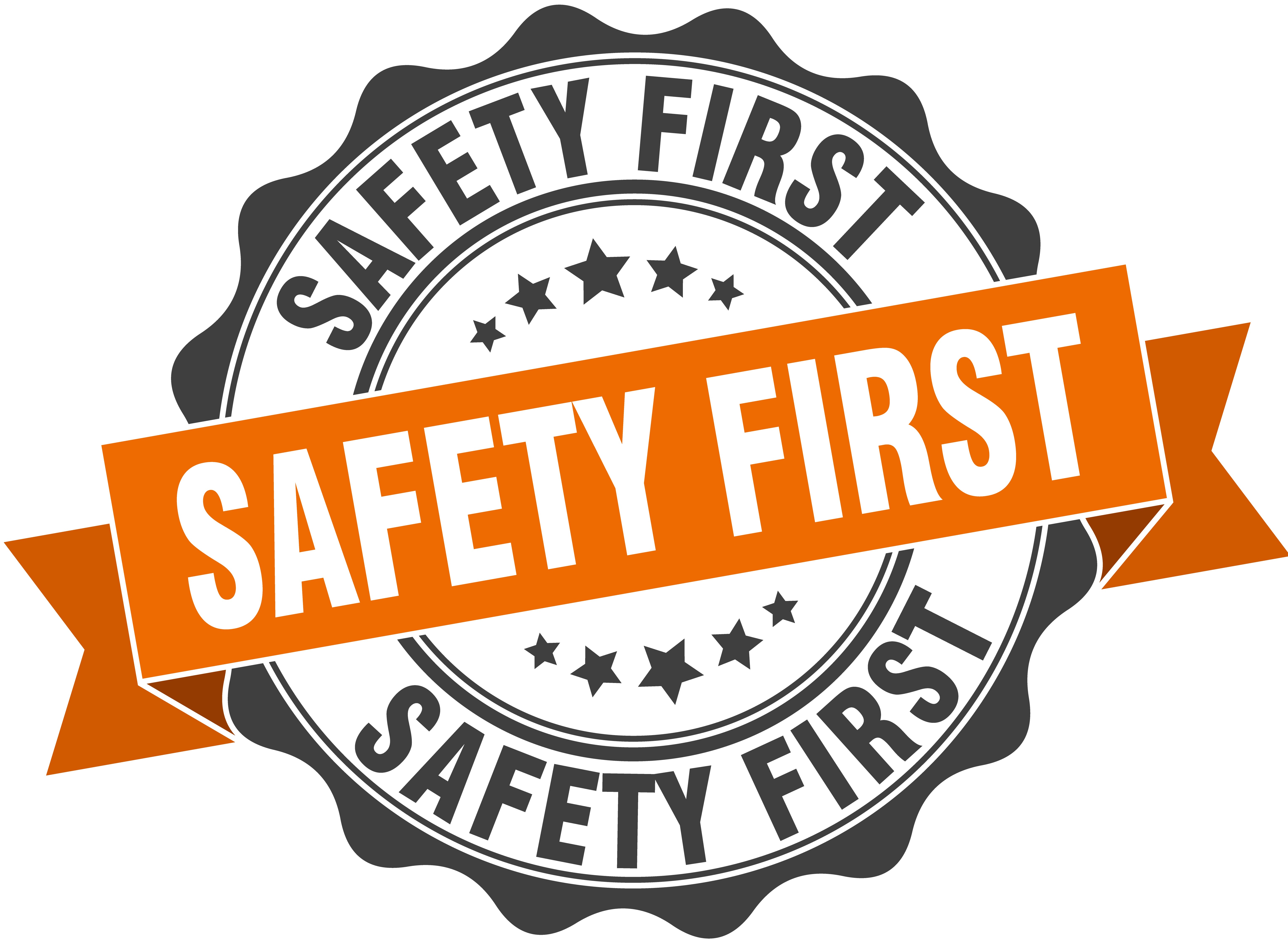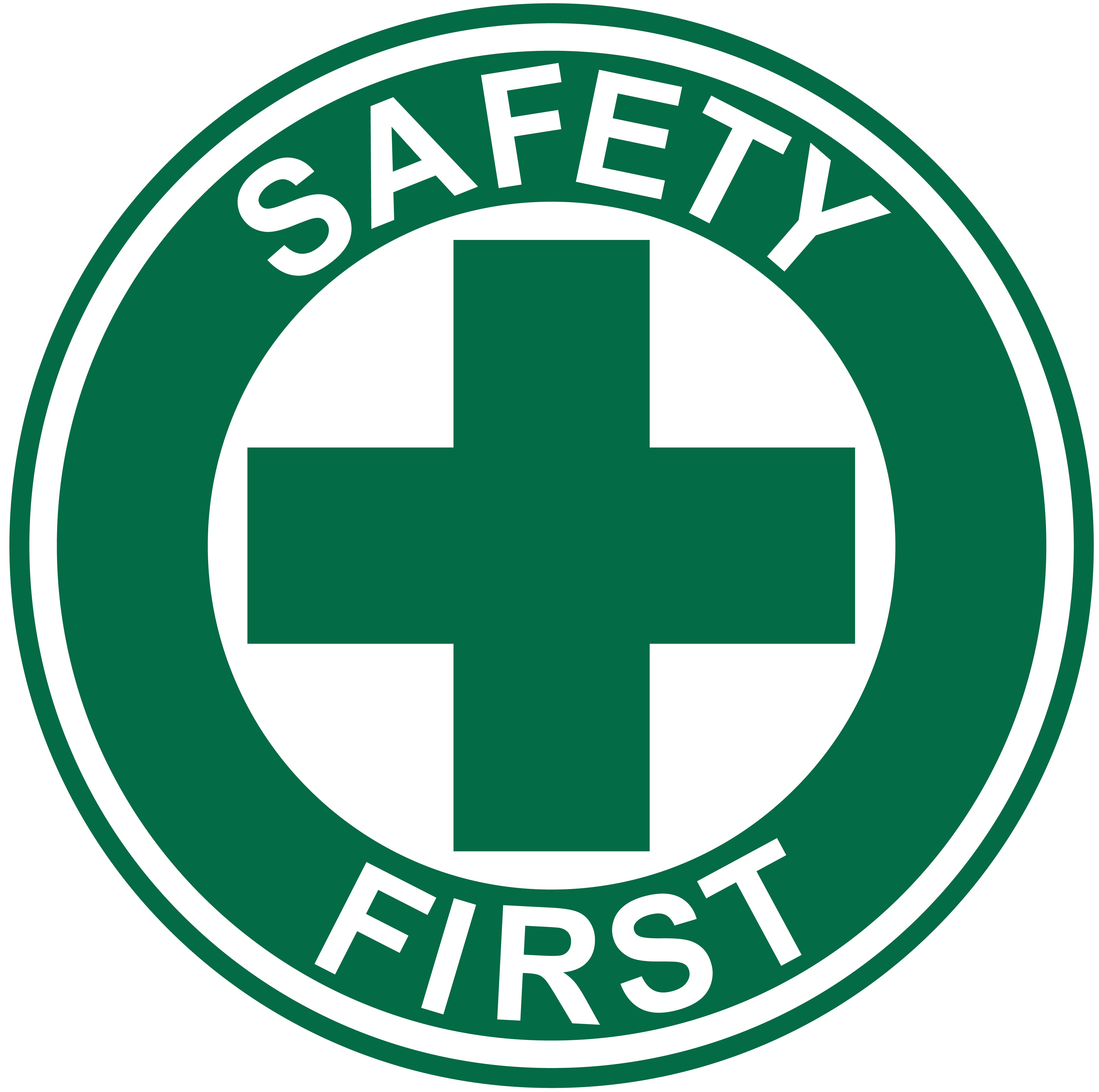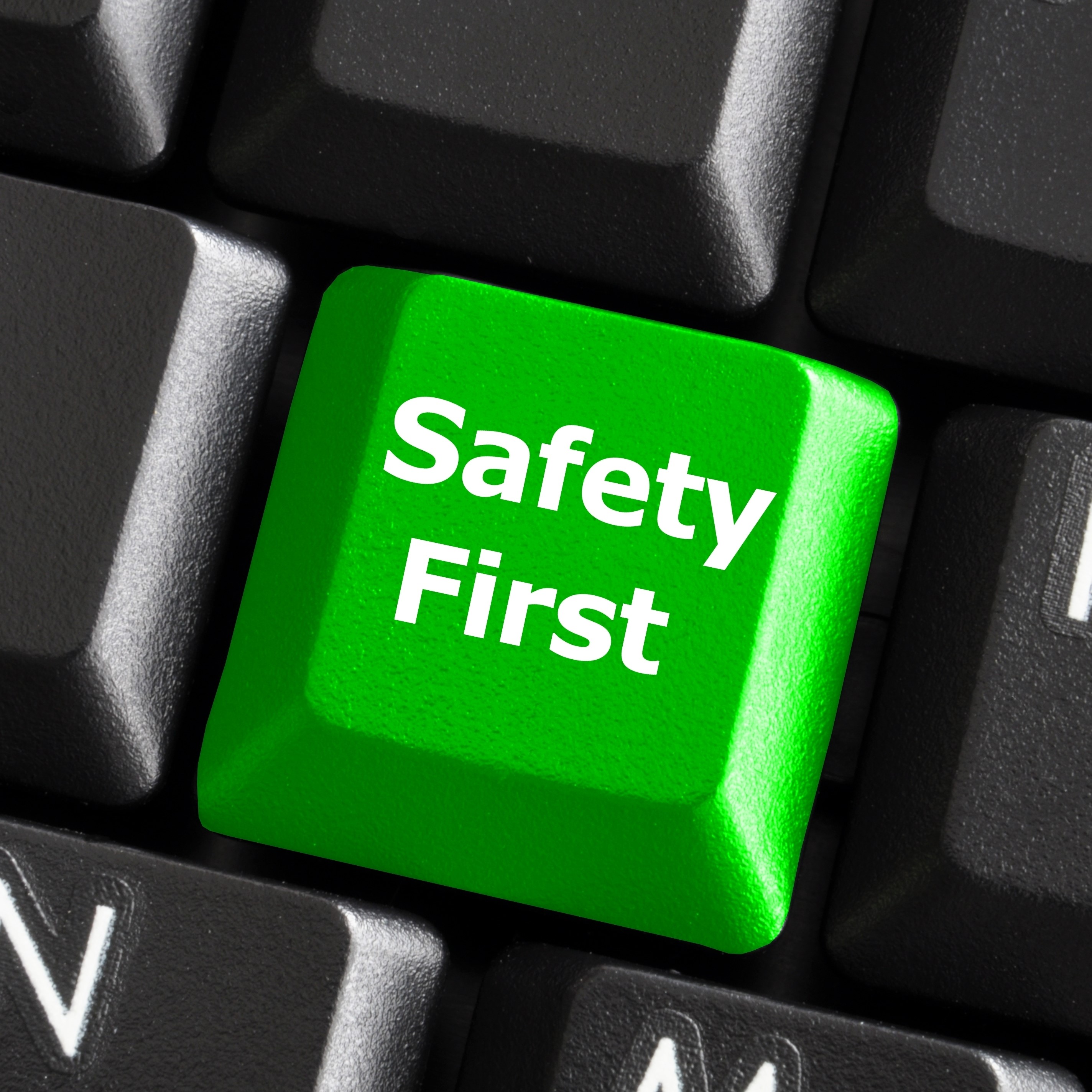Title Page
-
Conducted on
-
Conducted by
-
Department
-
Requirements for Communicating & Reviewing Inspection Results with Plant Management
FACILITY
ID Badges & Visitor Management
-
1. Employee ID Badges worn as required per EHS General Rules?
-
Specific Area(s) and provide name(s) of non-compliant employee(s) in notes
-
2. Contractor & Visitor Badges worn as required per Visitor Management Procedure?
-
Provide Name and Company of each
Security
-
1. Are outdoor lights undamaged and in proper working condition?
-
Specify area(s)
-
2. Is fencing in good condition (e.g. free of holes, broken posts, large ground clearance gaps)?
-
Specify area(s)
-
3. Are gates in good condition and working properly?
-
Specify area(s)
Emergency
-
1. Are all sprinkler system valves in the open position?
-
Specify area(s)
-
2. Any errors at the fire alarm system control?
HOUSEKEEPING
Interior
-
1. Is trash present in plant-work areas and/or floors?
-
Specify work station(s)
-
2. Are trash bins are emptied regularly?
-
Specify work station(s)
-
3. Are employees addressing cleanliness issues as they see them?
-
Specify work station(s)
Exterior
-
1. Is trash or other inappropriate debris present on facility grounds?
-
Specify area(s)
-
2. Are Employees smoking in Designated Smoking Areas Only?
-
Specify area(s)
-
3. Are there cigarette butt on the ground?
-
Specify area(s)
-
3. Areas around exits are free from materials, garbage and debris.
-
Specify area(s)
-
4. Areas around bay doors are free from materials, garbage and debris.
-
Specify area(s)
-
5. Area around waste water tank is free from materials, garbage and debris.
-
Specify area(s)
-
6. Items and materials stored outside are neat and orderly.
-
Specify area(s)
-
7. If items are being stored outside are they organized and in a manner that will prevent personal harm?
-
Specify area(s)
-
8. Facility storage areas are free of unusable materials and other debris.
-
Specify area(s)
STORM WATER (SWPPP)
Storm Water Run-off & Collection
-
1. Storm water runoff and collection ponds are free of visible pollutants and debris.
-
Specify Outfall
-
2. Equipment and other potential pollutants are maintained away from discharge points and drainage paths are protected.
-
Specify Outfall
-
3. Outfalls are free and clean of general trash and other inappropriate debris
-
Specify Outfall
-
4. Standing, flowing or run-off water present?
-
Is any of the following present: odor, color, solids, foams or oily sheen
Scrap Metal Recycling
-
1. Are Scrap Bins stored under some type of covering such as a canopy.
-
2. If Scrap Bins are not stored under cover are they tarped or covered to prevent accumulation of rain water?
-
3. Any oily residue on Scrap Metal?
-
4. Any residue on the ground indicating scrap bins are leaking?
SPILL PREVENTION (SPCC)
Spill Containment for In-Service Drums and/or Pails
-
1. Are all in-service drums stored on a proper secondary containment pad?
-
Specify work station(s)
-
1a. Are secondary containment pads in good condition? (no leaks, damage, dents)
-
Specify work station(s)
-
Indicate any issues found during inspection
-
1b. Are all secondary containment pads free of other objects that would reduce the containment volume in the event of a spill?
-
Specify work station(s)
-
2. Are in-service drums in good condition with no leaks?
-
Specify work station(s)
-
3.Are all in-service pails on a proper secondary containment pad?
-
Specify work station(s)
-
4. Are in-service pails in good condition with no cracks or leaks?
-
Specify work station(s)
-
5. Are all containers properly labeled?
-
Specify work station(s)
-
6. Are spill containment kits available nearby?
-
Specify work station(s)
-
7. Are adequate supplies available in spill kits?
-
Specify work station(s)
-
8. Are spill kits clearly labeled and easily accessible?
-
Specify work station(s)
Oil Storage
-
1. Are any IBC Totes damaged or leaking?
-
Specify work station(s)
-
2. Are any drums damaged or leaking?
-
Specify work station(s)
-
3. Are barrels completely sealed to prevent leakage?
-
Specify work station(s)
-
4. Any leaks or damage to secondary containment and/or coverage?
-
Specify work station(s)
-
5. Are any totes or drums stored outside?
Used Oil
-
1. Are used oil containers are in good condition?
-
Specify work station(s)
-
2. Are oil containers closed and/or funnel lids are attached unless oil is being added or removed?
-
Specify work station(s)
-
3. Are used oil containers labeled as "Used Oil"?
-
Specify work station(s)
-
4. Are empty oil containers for reuse designated as empty?
-
Specify work station(s)
-
5. Is used oil mixed with other wastes?
-
Specify work station(s)
-
6. Are spill kit(s) accessible and stocked appropriately for used oil storage?
-
Specify work station(s)
Above Ground Storage Tanks (USED OIL/WASTE OIL)
-
1. Any damage to tank body, footings and/or secondary containment?
-
2. Any spills present around storage tank?
Process Equipment & Dies
-
Leaks can occur from either the service side of tooling (dies) or from the structural seal failure side of the press or machine. In either case contamination can occur from the petroleum based product.
-
1. Are there any significant leaks from equipment containing oil?
-
Specify work station(s)
-
2. Are pads or absorbent materials being used consistently or as the main solution to contain leakage?
-
Specify work station(s)
-
3. Is excessive oil present in the die racks?
-
Specify work station(s)
-
4. Is excessive oil present around presses or equipment?
-
Specify work station(s)
-
5. Are pads or absorbent materials being used to contain leakage and keep the floor dry?
-
Specify work station(s)
-
6. Are hydraulic hoses in good condition with no damage or significant wear?
-
Specify work station(s)
Die Washer
-
Is there a die washer at the facility?
-
1. Is there any damage to die washer since last inspection?
-
2. Are there any leaks/overflow of the "closed-loop" system?
-
3. Any damage to the covering to allow rainwater to enter and overflow the system?
WASTE MANAGEMENT
General Waste
-
1. Is there any trash on the ground around containers?
-
Specify work station(s)
-
2. Are there any stains or residue on the ground that may indicate the container is leaking?
-
Specify work station(s)
-
3. Is the container in good physical condition (no excessive rust, holes, etc.)?
-
Specify work station(s)
UNIVERSAL WASTE
Aerosol Can Disposal
-
1. Are aerosol cans punctured and emptied before disposal?
-
Specify work station(s)
-
2. Is the lever and containment cover in good working condition?
-
3. Is lid of puncturing unit closed when not in use?
-
Specify work station(s)
-
4. Is a sticker stating "Lid must remain closed when not in use" on the lid of the drum?
-
5. Are aerosol cans placed in proper disposal bins after cans are punctured and emptied?
-
Specify work station(s)
-
6. Is a Hazardous Waste Label present on drum?
-
a) Accumulation start date indicated on the label?
-
Enter the Accumulation Start Date as MM/DD/YYYY
-
b) Waste shipped offsite within 1 year of accumulation start date?
Battery Disposal
-
1. Adequate signage to indicate location of disposal?
-
2. Are batteries (lead acid, rechargeable) properly stored?
-
3. Are waste batteries stored in closed container(s)?
-
4. Are containers in good physical condition?
-
5. Is lid secured to the container(s)?
-
6. Is the handle working properly?
-
7. Are waste batteries packaged so terminals will not come in contact with each other? (positive ends taped (Scotch) to prevent fire)
-
8. Is Universal Waste Label present on used batteries container(s)?
-
a) Accumulation start date indicated on the label?
-
Enter the Accumulation Start Date as MM/DD/YYYY
-
b) Waste batteries shipped offsite within 1 year of accumulation start date?
-
9. Are spill kit(s) accessible and stocked appropriately for waste batteries storage?
Waste Lamps / Fluorescent Light Bulbs
-
1. Adequate signage present to indicate location of disposal?
-
2. Are broken lamps stored separately in sealed container labeled with contents?
-
3. Is container kept closed unless lamps are being added or removed?
-
4. Are containers in good physical condition?
-
5. Is Is Universal Waste Label present on waste lamp container(s)?
-
a) Accumulation start date indicated on the label?
-
Enter the Accumulation Start Date as MM/DD/YYYY
-
b) Are waste lamps shipped offsite within 1 year of accumulation start date?
-
6. Are spill kit(s) accessible and stocked appropriately for waste lamp storage?
Parts Cleaner
-
1. Are waste solvents from all degreasing units stored in covered containers?
-
2. Is Standard Work, summarizing how to decrease emissions posted on or near the degreaser?
-
3. Is the unit equipped with a cover which is kept closed when parts are not being handled in the cleaner?
Polish Dust
-
1. Any signs of dust being washed off roofs and through down-spouts?
-
Specify work station(s)
-
2. Dust collector appears to be working properly?
-
Specify work station(s)
-
3. Any signs of damage to dust collector?
-
Specify work station(s)
-
4. Is there significant polishing dust on the ground?
-
Specify work station(s)
-
5. Does dust appear to be washing away from the immediate area?
-
Specify work station(s)
-
6. Are all dust containers covered?
-
Specify work station(s)
STORAGE OF GASES & CHEMICALS ON-SITE
Compressed Gas Cylinders
-
1. Is the area in and around where compressed gases are stored kept in neat and orderly manner to prevent additional hazards?
-
2. Are Safety Chains utilized across each section?
-
3. Are cylinders legibly marked to clearly identify the type of gas?
-
4. Are compressed gas cylinders stored in their marked section of the Compressed Gas Storage Area?
-
5. Are empty cylinders appropriately marked, their valves closed and stored in their marked section of the Compressed Gas Storage Area?
-
6. Are compressed gas cylinders stored in areas protected from external heat sources such as flame impingement, intense radiant heat, electric arcs, or high-temperature lines?
-
7. Are cylinders located or stored in areas where they will not be damaged by passing or falling objects or subject to tampering by unauthorized persons?
-
8. Are valve protectors always placed on cylinders when the cylinders are not in use or connected for use?
-
9. Are signs posted reading “DANGER, NO SMOKING, MATCHES, OR OPEN LIGHTS, ” or the equivalent?
-
10. Any corrosion, general distortion, cracks or any other defect to cylinders indicating a weakness or render them unfit for service?
ENVIRONMENTAL PERFORMANCE
Use of Energy
-
1. Any air leaks around production equipment?
-
Specify work station(s)
-
2. Any air leaks around hand tooling?
-
Specify work station(s)
-
3. Any Energy Conservation methods implemented and/or in place?
-
Specify work station(s)
-
4. Are Energy Conservation methods being followed?
-
Specify work station(s)
Recycling
-
Are Recycling Services available and present at plant?
-
1. Are recycling materials being sorted and containers utilized properly?
-
2. Are containers clearly marked and available?
-
3. Any improper disposal of recyclable materials in containers?
-
4. Recycling used copper tips and properly maintaining containers at collection stations?
Sign-off
Inspection Completion & Signature
-
Auditor
-
Plant Manager
-
Supervisor
-
Additional Personnel
-
Additional Personnel













